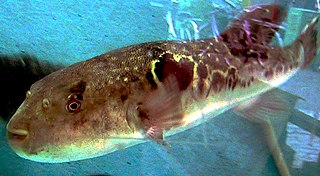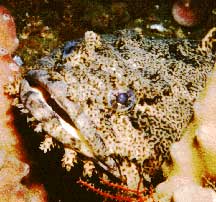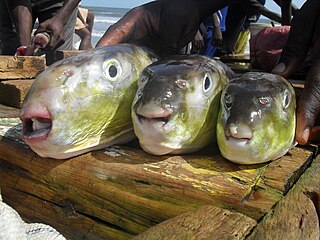
Tetraodontidae is a family of primarily marine and estuarine fish of the order Tetraodontiformes. The family includes many familiar species variously called pufferfish, puffers, balloonfish, blowfish, blowers, blowies, bubblefish, globefish, swellfish, toadfish, toadies, toadle, honey toads, sugar toads, and sea squab. They are morphologically similar to the closely related porcupinefish, which have large external spines. The scientific name refers to the four large teeth, fused into an upper and lower plate, which are used for crushing the hard shells of crustaceans and mollusks, their natural prey.

The fugu in Japanese, bogeo or bok (복) in Korean, and hétún in Standard Modern Chinese is a pufferfish, normally of the genus Takifugu, Lagocephalus, or Sphoeroides, or a porcupinefish of the genus Diodon, or a dish prepared from these fish.

The southern Amazon red squirrel, is a squirrel species from South America where it inhabits forests in much of north-western South America east of the Andes. Three subspecies are currently recognised. It is a dark red colour, or a dark brown grizzled with ochre, has whitish underparts and grows to a total length of 48 to 63 cm, including a very long tail. It spends much of its time on the ground in the undergrowth and feeds largely on nuts. Little is known of its breeding habits, but it is a sociable species, several individuals often feeding together in one tree. This squirrel faces no particular threats, has a wide range and is relatively common, and the International Union for Conservation of Nature lists it as a "least-concern species".

The dayak fruit bat or dyak fruit bat is a relatively rare frugivorous megabat species found only on the Sunda Shelf of southeast Asia, specifically the Malay Peninsula south of the Isthmus of Kra, and the islands of Borneo and Sumatra. There are three species in the genus Dyacopterus: D. spadiceus, D. brooksi and D. rickarti. All are found in the forests of Malaysia, Thailand, and the Philippines. Few specimens of any of the three species exist, due not only to their rarity, but also because they rarely enter the sub-canopy of the forest where they can be caught in scientists' nets.

Fish are aquatic, craniate, gill-bearing animals that lack limbs with digits. Included in this definition are the living hagfish, lampreys, and cartilaginous and bony fish as well as various extinct related groups. Approximately 95% of living fish species are ray-finned fish, belonging to the class Actinopterygii, with around 99% of those being teleosts.

Lagocephalus is a genus of fish in the family Tetraodontidae (pufferfish) with a circumglobal distribution.

The oceanic puffer, sci-name: Lagocephalus lagocephalus, is a pufferfish of the family Tetraodontidae, found in all tropical and subtropical oceans, at depths of between 10 and 475 m. Though indigenous to the Pacific, Atlantic and Indian oceans as well as the Sea of Japan, a surge in its distribution throughout the Mediterranean Sea has been reported in years of recent. Its length is up to 61 cm. It is thought to be responsible for fatal poisoning and should therefore not be eaten.

Lagocephalus lagocephalus oceanicus, is a pufferfish of the family Tetraodontidae, found in the western Pacific Ocean in temperate and tropical waters. Its length is up to 45 cm. The dorsal and anal fins falcate, the caudal fin is lunate. The lower one third of the pectoral fin is white. It is thought to be responsible for fatal poisoning, therefore it should not be eaten.

The rock greenling is a species of marine ray-finned fish belonging to the family Hexagrammidae, the greenlings. It is sometimes known as fringed greenling and erroneously as the red rock trout.
Sicyopterus lagocephalus, the red-tailed goby or blue stream goby, is a species of goby native to islands of the Indian Ocean from the Comoros to the Mascarene Islands to the Pacific Ocean where it reaches French Polynesia and can be found as far north as Japan. It is an amphidromous species: adults can be found in swift-flowing streams with rocky beds but the eggs hatch at sea and the larval stage remains in marine waters, migrating to freshwaters when they reach the postlarval stage. This species can reach a total length of 13 cm (5 in). In some places it is an important species for local consumption with the post-larvae being caught as they mass in estuaries.

Arothron stellatus, also known as the stellate puffer, starry puffer, starry pufferfish, or starry toadfish, is a demersal marine fish belonging to the family Tetraodontidae. It is found in shallow water in the Indo-Pacific region.

Toadfish is the common name for a variety of species from several different families of fish, usually because of their toad-like appearance. "Dogfish" is a name for certain species along the gulf coast.

Lagocephalus sceleratus, commonly known as the silver-cheeked toadfish, or Sennin-fugu, is an extremely poisonous marine bony fish in the family Tetraodontidae.
Philometra lagocephali is a species of parasitic nematode of fishes, first found off New Caledonia in the South Pacific Ocean in the abdominal cavity of Lagocephalus sceleratus. This species is characterized mainly by the length of its spicules, length and structure of its gubernaculum, body size, location in host and types of hosts.
The diamondback puffer is a species of pufferfish in the genus Lagocephalus.

Lagocephalus lunaris, also known as the lunartail puffer, is a species of fish in the family Tetraodontidae. It lives in areas in the Indo-Pacific, and its habitat is areas in coastal marine waters, at depths of up to 150 meters, in sandy bottoms, coastal reefs, estuaries and mangroves.

The electric eels are a genus, Electrophorus, of neotropical freshwater fish from South America in the family Gymnotidae. They are known for their ability to stun their prey by generating electricity, delivering shocks at up to 860 volts. Their electrical capabilities were first studied in 1775, contributing to the invention in 1800 of the electric battery.

Lagocephalus inermis, known as the smooth blaasop, is a species of pufferfish in the family Tetraodontidae native to the Indo-Pacific. It is a marine species that ranges from Algoa Bay in South Africa to southern Japan, where it occurs at a depth range of 10 to 200 m and inhabits the edge of the continental shelf. It is a very large pufferfish, reaching 90 cm SL. It closely resembles the Atlantic species Lagocephalus laevigatus, but it can be distinguished from that species by its black gill opening. Additionally, it does not overlap in range with L. laevigatus. It is reported to be demersal and oviparous.

Lagocephalus laevigatus, known as the smooth puffer, is a species of pufferfish in the family Tetraodontidae. It is native to the Western Atlantic, where it ranges from New England to Argentina, as well as the Eastern Atlantic, where it ranges from Mauritania to Namibia. Adults of the species are pelagic and found near continental margins, whereas juveniles are usually found closer to shore or offshore banks, with both occurring either alone or in small, loose groups. It occurs at a depth range of 10 to 180 m over sandy or muddy bottoms and is a very large pufferfish, reaching 100 cm in total length. The species feeds on fish and shrimp and can be dangerously toxic if ingested. It is known to be oviparous. It is sometimes confused with the related species Lagocephalus inermis which is native to the Indo-Pacific.
Lagocephalus suezensis is a species of pufferfish of the family Tetraodontidae. It is native to the western Indian Ocean and recorded in the Mediterranean Sea since 1977. It has since spread in the eastern Mediterranean Basin. It reaches 18 cm in total length and inhabits sandy and muddy bottoms down to 40 m. It is often confused with Lagocephalus sceleratus in Australia.















